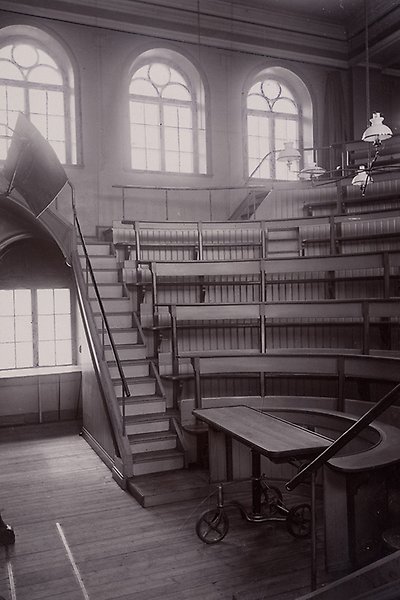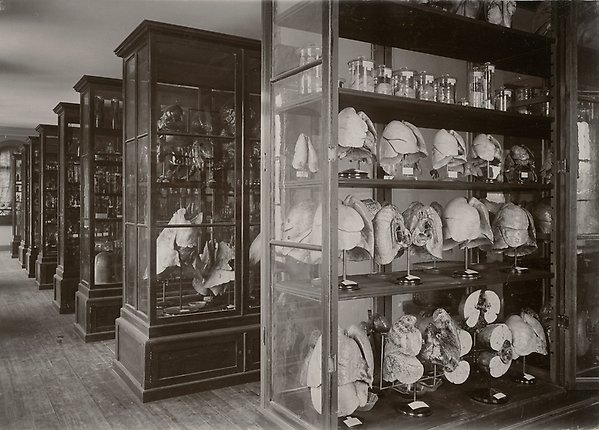Human remains in the University’s collections: vestiges of a different view of human beings
Research and education in medicine and natural sciences have a long history of using human remains. Important scientific discoveries have been made and new doctors have learned how to heal the sick and relieve suffering by studying human bodies.
Attitudes towards the treatment of human remains have changed since Uppsala University’s collections, and other similar collections, were built up. This is also true of views on the equal value of human beings, consent and the right to determine what happens to your own body after death.
The University holds human remains for the purpose of using them in the transmission of knowledge about the status of humankind within the biological sciences, for example, and to shed light on life in the past and historical behaviour. Present-day treatment of these remains is characterised by respect for individual integrity and complies with international professional museum standards.
Large anatomical collections built up
The mid-nineteenth century was a time of expanding medical training and research. It was also a time when large anatomical collections were built up in various places, including Uppsala University. These collections were regarded as important and vital both for medical research and for students’ education and training. A large collection of human remains was also a source of prestige for scientists and universities. Crania were perceived as particularly prestigious holdings in a collection.

The Department of Anatomy, around year 1880.
The scientists who built up the collections at Uppsala University primarily worked at the Department of Anatomy, which was then located on Trädgårdsgatan, where the Department of Law and the Institute for Housing and Urban Research are now situated. The Department of Anatomy was also home to the Anatomy Museum, which had several rooms at its disposal and contained collections from several branches of medicine.

Interior view of the lecture hall at the Department of Anatomy, around year 1880
Which bodies came to the Department of Anatomy?
Dissections of corpses were an important way to learn more about the human body. One major scientific discovery in connection with a dissection at Uppsala University, for example, was Ivar Sandström’s description of the human parathyroid glands in 1877.
The bodies that might be available for such studies at that time generally belonged to people who had died in prison or institutional care, deceased residents of charitable institutions with no means to pay for their own burial, or people who had been executed.
Many bodies that were dissected for research or educational purposes were afterwards buried. Some bodies, or parts of bodies, were saved in the medical collections, whether as mounted skeletons, as tissue samples on glass slides or as ‘wet specimens’, where organs were stored in preserving fluids.

The large exhibit hall at the Department of Anatomy, around year 1880.
Collections enlarged by networking
To build up reference collections for their specific research issues, scientists at different universities exchanged remains, or anatomical specimens, as they were called. Specimens were sometimes also donated by medical practitioners. Uppsala University had a large collection of women’s pelvises, for example, which were used in research on obstetric complications. This collection was later dispersed. Scientists also collected human and animal embryos.
In addition, scientists at the University purchased remains that seemed interesting from other parts of the world and received remains as gifts from ‘explorers’.
The collections and the documentation associated with them reveal that scientists at this time were particularly interested in skulls. There was also great interest in remains from ethnic groups that were perceived as ‘exotic’.
Some older remains were collected by archaeologists and anatomists jointly, as they had certain interests in common. The issues studied by archaeologists concerning the origin, evolution and history of the Swedish people were closely related to the anatomists’ attempts to classify bodies from different parts of the world.
Sami skeletons in the University’s collections
Like most of the anatomical collections, the Sami skeletons came to the University towards the end of the nineteenth century and in the early twentieth century. Some remains were bought by private individuals and donated to the Department of Anatomy while others were collected by excavations at Sami burial grounds.
There are currently remains from 36 individuals of presumed Sami origin in the University’s historical collections: 2 individuals from Sweden, 6 individuals from Norway and 28 individuals from Russia. In addition, there are remains of 18 individuals deposited at Ájtte, the Swedish Mountain and Sami Museum, in Jokkmokk.
The remains now at Ájtte come from an archaeological excavation of Rounala churchyard north of Karesuando carried out in 1915 that was commissioned by researchers in anatomy at Uppsala University. According to contemporary accounts, 2 skeletons and 21 crania were dug up and taken to Uppsala.
In 2022, the University received a request for repatriation from the Sami Parliament regarding the remains from Rounala churchyard. The matter is being prepared by the University.
Anatomy researchers stopped collecting
At the start of the 1930s, the collections began to be gradually moved out of the Department of Anatomy’s premises to make room for other activities. Acquisitions came to a stop and parts of the collections were put into storage. Anatomical collections were no longer regarded as being at the heart of medical research and education.
In 1968 the Department of Anatomy moved to new premises at the Uppsala Biomedical Centre (BMC). The collections were packed away. The Department of Anatomy was later closed and its activities were transferred to other departments.
Collections ‘rediscovered’
In connection with moves and relocations in 1996, parts of the anatomical collections were found in the University’s storage facilities. In 1997, these objects were handed over to the National Historical Museums. The parts of the anatomical collection that had been kept at the Department of Medical Cell Biology were transferred to Uppsala University’s Museum Gustavianum in 2009.
In 2010, an osteologist was employed to make an inventory of the collection of bones. After it became apparent that parts originating from the same individuals had ended up at different museums, a decision was made in 2011 that Gustavianum should also take care of the part of the collection that had previously been handed over to the National Historical Museum. The purpose of this was to reunite parts belonging to the same individual, as far as possible.
What do the collections contain today?
Gustavianum manages the University’s historical collections. The holdings include over 1,000 crania and 100 mounted skeletons. There are also organs (e.g. lungs), as well as plaster casts of crania and death masks.
The inventory of the anatomical collection is largely complete, though some work remains to be done. There are several catalogues drawn up by the scientists who collected the remains. Various types of information are registered in them, such as age, sex and specific deviations that the scientists considered interesting, but no names of individuals.
In 2000, the Museum of Evolution was established at Uppsala University. Its holdings include just over 40 preserved anatomical parts and many thousands of slides with thin tissue samples (sections) from human beings and animals that were collected by the Department of Anatomy.
Most of the objects in the obstetric collection, which included the pelvises, are now in the Museum of Medical History.
One existing misconception is that there are human remains from the Institute for Racial Biology, which was located in Uppsala, and that these remains would be held at Uppsala University. However, no such material exists. What does exist is the archive from the Institute for Racial Biology, which is managed by Uppsala University.
Archaeological material
The vast majority of the human skeletal materials in the University’s collections come from archaeological excavations of burial sites in Sweden. The Gustavianum collections contain remains from archaeological investigations from 1926 onwards, for example from Valsgärde in Uppland and from the prehistoric settlement of Asine in Greece.
How are the collections stored today?
The anatomical collections are kept in specially adapted premises that are not open to the public. The remains are sometimes on display in exhibitions associated with current research on how people lived in the past and diseases. However, remains from indigenous peoples or from ongoing repatriation cases are never exhibited. Since 1997, old museum display cases with parts of the old anatomical collection have been exhibited at the Uppsala Biomedical Centre campus.
Uppsala University’s Guidelines for the handling and conservation of human remains.
Ethical guidelines from the International Council of Museums (ICOM)
What is the University’s view on repatriation?
On several occasions, Uppsala University has repatriated – i.e. returned – human remains taken from their original places. The University is a public authority and follows the existing regulatory framework. Repatriation depends on a request being received and there has to be a legitimate recipient. It is the government that ultimately decides on repatriation.
Previous repatriations
Uppsala University has been involved in the following repatriations to date:
- 2015 Crania repatriated to French Polynesia (together with Karolinska Institutet).
- 2020 Cranium of a Sami man to Lycksele (together with the National Historical Museums).
- 2022 Skeleton of a Sami man from Arjeplog.
2022 Ongoing repatriation proceedings concerning the remains of 18 individuals deposited at Ájtte, the Swedish Mountain and Sami Museum, in Jokkmokk. The University has recommended repatriation and turned the case over to the government for a decision.
References
- Helena Franzén (2022) Kroppar i förvandling: Obstetriska och embryologiska samlingar vid Uppsala universitet, ca 1830-1930. Doctoral thesis.
- Ingvarsson-Sundström, A., & Metz, G. (2012). Museum Anatomicum Upsaliense. I Uppsala mitt i Sámpi: Rapport från ett symposium arrangerat av Föreningen för samiskrelaterad forskning i Uppsala, Upplandsmuseet 4–5 maj 2011 (p. 66–70).
- Ojala, C-G. 2009, Sámi Prehistories. The Politics of Archaeology and Identity in Northernmost Europé. Uppsala
- Svanberg, Fredrik (2015). Människosamlarna: anatomiska museer och rasvetenskap i Sverige ca 1850-1950. Stockholm: Swedish History Museum
